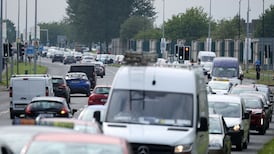SOCIETY AND technology have changed markedly since Met Éireann was established in 1936 – but the Irish fascination with weather has not waned.
The service marked its 75th anniversary yesterday and, having forecast its way through a world war, recessions and decades of sun, snow and rain, it remains a central player in Irish life.
“The challenges we face have changed because society has changed,” said Met Éireann head of forecasting Gerald Fleming. “We live in a more urban society now . . . The interruption of infrastructure can have a big impact and this was exemplified by the floods in Dublin last month.”
Some 15 years after Independence, the Irish Meteorological Service was formed, and rebranded as Met Éireann in 1996, to take over the reins from the British Meteorological Office.
Operations began out of St Andrew’s Street in Dublin under director Austen H Nagle, but it was not until 1941 that the service’s recruits were trained and it could satisfy increasing demand for weather reports on its own.
Aviation provided the initial impetus for the service, as it specifically aimed to provide reports for the firms behind the flying boats making transatlantic voyages from Foynes, Co Limerick, to Newfoundland in eastern Canada. After the second World War, the farming sector drove demand as Ireland sought to subsist and provide supplies to the UK.
The service took on the forecasts broadcast by Radio Éireann in 1948, before a move to supplying daily newspapers in 1952 and TV bulletins in 1962.
“The first director general of RTÉ [Edward J Roth] did not last all that long but he was from the US where weather broadcasting was a big deal and he insisted it was needed,” Mr Fleming said.
“If it weren’t for him it might have been a long time before we had televised weather forecasts.”
Technology was a major driver of change, with timber and brass feats of Victorian engineering eventually replaced by satellites and digital mathematical models.
Met Éireann forecasts are “a lot more accurate now than at any stage”, Mr Fleming said. “We have graphs to show the accuracy has continued to increase through the last 30 or 40 years.”
Now five-day and six-day forecasts are quite reliable, he said.
It moved to its landmark offices in Glasnevin, Dublin, in 1979.
“A lot of forecasters from other countries actually envy us because of the range of weather we have here,” Mr Fleming said. “An Israeli forecaster once told me we were lucky in Ireland because he had nothing to report in his bulletins for five months of the year because it’s sunny all the time.”









